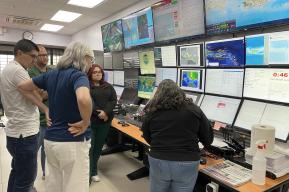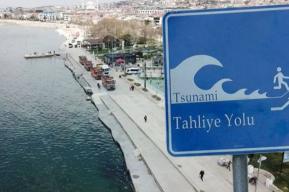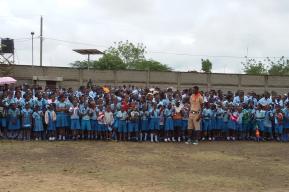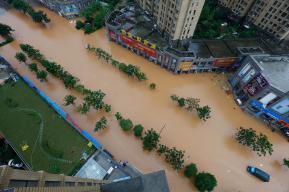Kadri shares his visions for the future of tsunami prediction, highlighting the role of AI alongside traditional methods, and talks about his collaboration with UNESCO’s Intergovernmental Oceanographic Commission (IOC/UNESCO), which has been supporting and facilitating his and other relevant research on tsunami early warning science and technology.
IOC/UNESCO: Can you briefly explain how you went about developing a tsunami prediction model based on AI? How does it differ from traditional approaches?
Usama Kadri: Traditional approaches present various challenges, advantages, and disadvantages. Existing warning systems rely on DART-buoys and seismic measurements. DART-buoys accurately measure tsunamis upon their arrival but offer limited warning time, high costs, and maintenance difficulties. Seismometers promptly detect earthquakes but struggle to provide reliable tsunami measurements, leading to false alarms or even false negatives. Numerical models require extensive processing time and are mostly used for post-processing, whereas pre-calculated probabilistic models carry a high risk of false negatives.
Our approach complements current technology by analysing sound signals recorded by underwater hydrophones. These signals travel much faster than tsunamis, carrying information of the source. We have developed two independent models: an AI model and an Analytical model. The AI model analyses streamed sound signals, determining earthquake type and magnitude to predict tsunami generation in a fraction of a second. The Analytical model evaluates the signals in real-time, inversely assessing water layer properties and calculating tsunami size globally. Combining the two models with traditional approaches increases confidence in the assessment process and enhances the overall warning system reliability.
Tsunami prediction is a complex and critical task. What are some of the main challenges you faced while developing the AI-based model, and how did you overcome them?
For the AI-based model, one major challenge is the limited amount of data available for large magnitude earthquakes. To overcome this, we used the available data and trained the AI model with a conservative approach for larger earthquakes. To enhance the accuracy of the predictions further, we are currently working on incorporating tens of thousands of historical data to be validated against known tsunamis. On the other hand, there is a need to assess the tsunami size on large coastal areas in real-time. To overcome the costly computations, we solved the mathematical problems analytically, making a breakthrough in the computation approach. For example, assessing the tsunami size on all coastlines associated with the 2004 Sumatra earthquake takes less than half a minute of signal analysis on a standard multicore station PC.
How do you envision the future of tsunami prediction? Do you believe that AI will play a more significant role in enhancing our ability to forecast and mitigate the impact of tsunamis? If so, how?
AI models can provide more accurate and timely warnings, reducing false alarms and improving response measures, there is no doubt about that. However, training an AI model properly requires a deep understanding of the tsunami generation and propagation mechanisms which could be very challenging, and requires continuous research and analytical model development. In addition, to optimise the alarm system and minimise potential risks, we need to adapt a complementary approach that integrates AI with independent models, e.g., analytical, alongside traditional approaches. The Intergovernmental Oceanographic Commission (IOC) of UNESCO plays a key role in promoting international cooperation around tsunami early warnings and preparedness.
How do you see the role of organizations like the IOC in supporting experts like you in testing and mainstreaming AI-based tsunami prediction models?
A few years ago, I presented some initial findings about our real-time warning technology at a conference. It was there that I met Bernardo Aliaga, who leads the Tsunami Resilience Section at IOC/UNESCO. Aliaga was impressed by our technology and our global warning approach. Thanks to him, we decided to take the technology to the next level and make it fully operational. Since then, Aliaga and his colleagues at UNESCO have been incredibly supportive, and we have formed a special partnership. This partnership is important because it gives us a platform to collaborate and discuss the different stages of our technology with tsunami experts. It also facilitates access to real-time data, which would allow us to test the technology in real operational environments. Through its IOC, UNESCO has been liaising with Tsunami Warning Centres to host our latest operational software as a pilot for global real-time tsunami warning. Overall, UNESCO’s role is vital in fostering cooperation, advancing technology, and promoting the use of state-of-the-art Tsunami models to enhance global tsunami preparedness and response efforts.
In addition to your research, what other initiatives or collaborations are you involved in to raise awareness about tsunami prediction and enhance public safety? How important is it to educate and engage communities in high-risk areas about the potential dangers and preparedness measures for tsunamis?
I am actively engaged in various initiatives and outreach activities to increase awareness about tsunami prediction and mitigation, with the goal of enhancing public safety. It is crucial to engage and educate the public to ensure the preparedness and safety of communities, not only in regions prone to tsunamis but also globally. The 2004 Sumatra tsunami serves as an example, where many of the victims were tourists from regions with low tsunami risk. This highlights the importance of global awareness for effective preparedness and response efforts. Higher education plays a significant role in fostering this awareness. To contribute to this cause, I am actively involved in a new initiative led by the University for Education for Sustainable Development. This initiative aims at raising awareness among our colleagues and redesigning teaching curricula to include UNESCO's Sustainable Development Goals (SDGs). By incorporating the SDGs into education, we can promote a broader understanding of the importance of tsunami preparedness and mitigation.
In the future, I personally aspire to collaborate closely with local communities residing in high-risk areas to gain more insights into their specific challenges and needs. I plan to take part in conducting more workshops, organising awareness campaigns, and providing resources to assist these communities in understanding the significance of early warnings, developing optimised evacuation plans, and building resilient infrastructure. Through these efforts, we can empower communities to take proactive measures and protect themselves from the devastating impact of tsunamis.
As a senior lecturer and researcher, what advice would you give to aspiring scientists who are interested in working on AI-based models for natural disaster prediction? What about advice for young high school students trying to decide a field of study?
My advice for aspiring scientists interested in working on AI-based models for natural disaster prediction is to focus on interdisciplinary studies. It is important to have a strong foundation in both the scientific field you are interested in and the relevant AI techniques. Collaboration with experts from different disciplines, such as oceanography, acoustics, geology, seismology, mathematics and computer science, can provide valuable insights and expertise. For high school students, I would encourage them to explore their passion for science and consider the impact they can make in fields related to natural disaster prediction and mitigation. It's an exciting and important area that requires a lot of dedication, continuous learning, and the desire to contribute to the well-being of society.










